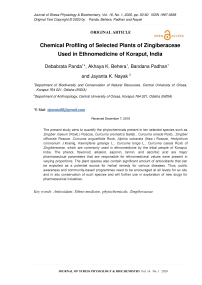Chemical profiling of selected plants of Zingiberaceae used in Ethnomedicine of Koraput, India
Автор: Panda Debabrata, Behera Akhaya K., Padhan Bandana, Nayak Jayanta K.
Журнал: Журнал стресс-физиологии и биохимии @jspb
Статья в выпуске: 1 т.16, 2020 года.
Бесплатный доступ
The present study aims to quantify the phytochemicals present in ten selected species such as Zingiber roseum (Roxb.) Roscoe, Curcuma aromatica Salisb., Curcuma amada Roxb., Zingiber officinale Roscoe, Curcuma angustifolia Roxb, Alpinia calcarata (Haw.) Roscoe, Hedychium coronarium J.Koenig, Kaempferia galanga L., Curcuma longa L., Curcuma caesia Roxb of Zingiberaceae , which are commonly used in ethnomedicine by the tribal people of Koraput, India. The phenol, flavonoid, alkaloid, saponin, tannin, and ascorbic acid are major pharmaceutical parameters that are responsible for ethnomedicinal values were present in varying proportions. The plant species also contain significant amount of antioxidants that can be exploited as a potential source for herbal remedy for various diseases. Thus, public awareness and community-based programmes need to be encouraged at all levels for ex situ and in situ conservation of such species and will further use in exploration of new drugs for pharmaceutical industries.
Antioxidant, ethnomedicine, phytochemicals, zingiberaceae
Короткий адрес: https://sciup.org/143171154
IDR: 143171154
Текст научной статьи Chemical profiling of selected plants of Zingiberaceae used in Ethnomedicine of Koraput, India
Plants are rich source of many potent and powerful drugs used in different countries (Gislene et al., 2000). Out of nearly, 2,50,000 plant species on earth, more than 80,000 are medicinal in nature. About 5000 species are extensively used in traditional systems of medicine. Among the various groups of plants, Zingiberaceous plants are quietly used in the ethnomedicinal purposes from time immemorial (Singh et al., 2003). Zingiberaceae or Ginger family is one of the largest monocot family in the order Zingiberales, have a great diversity with 53 genera and over 1300 species (Peter, 2007). Most of the species distributed mainly in tropics and subtropics of south East Asia and Africa (Larsen et al. 1999). Zingiberaceae produces aromatic rhizomes that are above the ground or subterranean (Soepadmo, 1976). Most of the species under this family are easily recognized by the aromatic characteristic of the leaves and fleshy rhizome. In South-East Asian region, several species of Zingiberaceae are used as spices, condiment, traditional medicines, flavouring agents and as the source of certain dyes (Burkill, 1996; Larsen et al., 1999). In India some of these plants are underutilized crop of the country and have some role in food security and some are used by various indigenous systems of medicine (Peter, 2004). These plants are well known due to their importance in food, spice, medicinal and ornamental values (Sivarajan and Balachandran, 1994). The important genera coming under Zingiberaceae are Curcuma, Kaempferia, Hedychium, Amomum, Zingiber, Alpinia and Elettaria. They are well known for their use in traditional medicine (Prakashi et al., 1995; Hussain et al., 1992; Jain and Prakash, 1995).
Koraput district of Odisha state in India is belongs to the part of Eastern Ghats mountain ranges, one of the centres of diversity for many food crops and forest species (Mishra and Chaudhury, 2012; Mishra et al., 2008).These regions are dominated with tribal populations and is blessed with rich and diverse cultural heritage. The tribal people of this region possess rich knowledge and wisdom regarding plants including their usage for treating common ailments (Mishra and Choudhry, 2012). Previous reports showed nearly seven species of plants under Zingiberaceae family are used by the tribal communities of Koraput (Padhan and Panda, 2016; Padhan and Panda, 2015; Raut et al., 2013). Apart from that few reports also suggest the ethno-botanical use of Zingiberaceae plants by the tribal communities of the Koraput (Mishra and Chaudhury, 2012; Mohapatra and Panda, 2012; Misra et al., 2012; Misra and Misra, 2013; Misra and Misra, 2014; Padhan and Panda, 2016; Padhan and Panda, 2015; Raut et al., 2013). The rich tribal areas of South Odisha particularly Koraput have given less attention in relation to validation of the ethno-medicinal importance of these species. However, most of these reports are incomplete and inadequate and no report is available about phytochemical and antioxidant profiling of medicinal plants of Zingiberaceae family. Owing to the significance of the above context, phytochemical screening of Zingiberaceae plants for pharmacological activity and bioactive compositional information is necessary to validate the use of these plants in the traditional medicine.
MATERIALS AND METHODS
Collection and characterisation of plant samples
The rhizomes of ten selected ethnomedicinal plants namely Zingiber roseum (Roxb.) Roscoe, Curcuma aromatica Salisb., Curcuma amada Roxb., Zingiber officinale Roscoe, Curcuma angustifolia Roxb, Alpinia calcarata (Haw.) Roscoe, Hedychium coronarium J.Koenig, Kaempferia galanga L., Curcuma longa L., Curcuma caesia Roxb of Zingiberaceae , were collected from different forest patches of Koraput district (Fig. 1 and Fig. 2). The ethnomedicinal importance and their tribal use was presented in Table 1. The collected plants were carefully examined and identified with the help of Flora of Orissa by Saxena and Brahmam (1994 -1996). The rhizomes were oven dried at 40° C and powdered mechanically, sieved and stored in an airtight container for further phytochemical analysis.
Phytochemical quantification
The phenol content was determined using the method of Sadasivam and Manickam (2007) with some modifications. The samples (0.1 g) were refluxed in 80% methanol and evaporated and the volume of the crude extract was made up to 10 ml. An aliquot was prepared with 1 ml extract, 0.5 ml Folin-Ciocalteu’s reagent (Himedia) (2:1) and 2 ml 20% Na2CO3 and the mixture was incubated in a water bath at 90 to 95°C for 2 min. The absorbance was measured at 650 nm and the total phenol content was expressed as gallic acid equivalence (GAE) mg g-1 Dwt. using gallic acid as a standard.
Total Flavonoid content was determined by Aluminium chloride colorimetric assay with some modification according to Chang et al., (2002).The crude extracts (0.5 ml) were diluted with 1.5 ml of methanol. To this 0.1 ml AlCl 3 , 0.1 ml Potassium acetate, 2.5 ml distilled water mixed well and allowed to stand for 30 min. The absorbance was measured at 415 nm with spectrophotometer. Results were expressed as mg flavonoid g-1 of dry samples using quercitin as standard.
Total tannin content of the samples was determined using the Folin-Dennis spectrophotometric procedure described by Sadasivam and Manickam (2007). The tuber samples (0.1 g) were dissolved in 20 ml distilled water, heated for 20 min and centrifuged at 6000 rpm for 15 min. An aliquot of 0.5 ml extract was diluted to 10 ml and mixed with 0.5 ml Folin Dennis reagent (100 g sodium tungstate, 2 g phosphomolybdic acid with 50 ml phosphoric acid) and followed by addition of 1 ml 10% Na 2 CO 3 solution and incubated for 30 min. The intensity of colour was measured at 760 nm and the tannin content was expressed as mg g-1 Dwt. using tannic acid as a standard.
Total alkaloid content was estimated using the gravimetric method of Harborne (1973). The samples (1 g) were extracted with 40 ml 10% acetic acid in methanol and incubated for 4 h. The solution was filtered and the filtrate was evaporated in a water bath at 80 to 90°C. To the extract, ammonium hydroxide solution was added drop wise until the precipitation was complete. The solution was incubated for 2-3 h and the precipitate was filtered and the filtrate was washed with 1% ammonia solution and allowed to stand for 30 min. The residue was oven dried and weighed to quantify the alkaloid and the value was calculated as mg 100 g-1 Dwt.
The saponin content in the samples was determined using the method of Nahapetian and Bassiri (1974). The samples were extracted in 20% ethanol and re-extracted with diethyl ether and n-butanol in a separating funnel.
The mixture was washed twice with 5% aqueous sodium chloride. The upper layer was collected and evaporated. After evaporation the samples were dried in the oven to constant weight. The saponin content was calculated as mg g-1 Dwt.
The total Ascorbic acid content was determined by (Omaye et al., 1962). To 0.5 ml extracts were taken in the glass vials and then mixed by adding 0.1 ml of DTC reagent solution. After incubation 0.75ml of ice cold 65% H 2 SO 4 was added to the solution and the tube were allowed to stand at room temperature for additional 30 min. Colour was developed and absorbance was measured at 520 nm against blank. The ascorbic acid content was calculated by using the standard and express as % on dry weight.
Estimation of total antioxidant
The total antioxidant capacity of the extract was evaluated by the Phospho-molybdenum method with some modification of Prieto et al., 1999. An aliquot of 300 µl of tuber extract was mixed with 3 ml of the reagent solution (0.6 M sulphuric acid (H 2 SO 4 ), 28 mM sodium dihydrophosphate dehydrate and 4 mM ammonium hepta-molybdate tetrahydrate) and allowed to incubate in water bath at 90°C of 90 min. Then absorbence was measured at 695 nm against blank after complete cooling. The percentage of antioxidant activity as calculated by following equation.
Antioxidant activity (%) = (A sample - A blank /A ascorbic acid – A blank ) × 100
DPPH radical scavenging assay
The free radical scavenging activity of all the sample extracts was evaluated by DPPH according to Blois, 1958 with some modifications. The stock solutions of the tuber extracts were prepared to the concentration of 1 mgml-1. Briefly, the solution of DPPH (0.1 mM in methanol) of 1 ml was added to 3 ml of various concentrations (100 to 1000 µg/ml) of tuber extract. The mixtures were shaken vigorously and incubated at room temperature for 30 min in the dark. The reduction of the DPPH free radical was measured at 517 nm using UV-VIS spectrophotometer against a control contains DPPH and methanol. Ascorbic acid was used as reference. The capability of the scavenging the DPPH radical was calculated by using the following formula
DPPH radical scavenging activity (% inhibition) = (A control
– A test )/ A control ×100
(Acontrol—Atest) Acontrol
* 100
Where, A control is the absorbance of the control and A test is the absorbance of samples.
ABTS radical scavenging assay
ABTS radical scavenging assay was carried out with slight modifications of Re et al., 1999. The stock solutions included 7 mM ABTS solution and 2.4 mM potassium persulfate solution. The working solution was then prepared by mixing the two stock solutions in equal quantities and allowing them to react for 12-16 h at room temperature in the dark. The resulting solution was then diluted with ethanol to an absorbance of 0.706 ± 0.02 at 734 nm using the spectrophotometer. Various concentrations (100 to 1000 µgml-1) of the tuber extracts (1 ml) were allowed to react with 2.5 ml of the ABTS solution and the absorbance was taken at 734 nm after 7 min. The ABTS scavenging capacity of the extract was compared with that of trolox and percentage inhibition was calculated as
ABTS radical scavenging activity (%) = (A control – A test )/ A control × 100
Where A control is the absorbance of ABTS radical+methanol; A test is the absorbance of ABTS radical with sample extract as standard.
RESULTS AND DISCUSSION
Phytochemical compositions
Phytochemical compositions were compared among 10 selected plants of Zingiberaceae family from Koraput, India. Significant differences (P<0.05) existed in phenol content among the selected plants and it was varied from 2.6 to 41.6 mg g-1 dry sample (Fig. 3). The phenol content was higher in C. longa followed by Z. officinale and A. calcarata compared to the other plants. Similar results also reported for Curcuma, Zingiber and Alpinia species (Chan et al., 2008). The phenolic compounds are one of the largest and most ubiquitous groups of plant secondary metabolites, possess bioactivities such as anti apoptosis, anti-aging, anti-carcinogen, antiinflammation, anti-atherosclerosis, cardiovascular protection and cell proliferation activities (Han et al., 2007). The high potential of phenolics to scavenge free radicals may be due to many phenolic hydroxyl groups they possess (Atmani et al., 2009). Similarly, the flavonoid content varied from 1.13 to 15.48 mg g-1 among the plants (Fig. 3). The total flavonoid content was significantly higher in C. longa followed by Z. officinale and C. caesia and lowest was observed in C. aromatica. The phenol and flavonoid possess diverse biological activities which might be related to their antioxidant activity (Huang et al., 2009).
The values of alkaloid and saponin content was varied from 2.09 to 10.62 and 10.31 to 35.85 %, respectively among the studied plants (Fig. 4). The alkaloid content was significantly higher in C. longa followed by H. coronarium and C. amada . Whereas the saponin content was significantly higher in C. aromatica followed by Z. roseum and C. caesia . The lowest saponin content was observed in C. longa (10.31%). The presence of alkaloids and saponin in the studied species indicates their uses in medicines as alkaloids and saponin have biological functions with therapeutic efficacy (Sreevidya and Mehrotra, 2003; Okwu and Okwu, 2004). The tannin content in the selected plant samples were varied from 0.65 mg g-1 to 3.63 mg g-1 (Fig. 4). The tannin content was significantly more in A. calcarata followed by H. coronarium and Z. officinale . The plants with tannin-rich have been used for the treatment of diseases like leucorrhoea, rhinnorhoea, healing of wounds and diarrhea (Eleazu et al., 2013).
Total ascorbic acid and antioxidant capacity
The screening of antioxidant properties in medicinal and food plants have been investigated for finding an efficient remedy for several diseases (Halliwell, 2008). The ascorbic acid and total antioxidant capacity in the selected plant samples are shown in Fig 4. The ascorbic acid content was varied from 0.11 to 0.73 mg g-1 (Fig. 5).The ascorbic acid content has direct effect on medicinal properties in plant part used for treatment of various types of diseases. Among the selected plants C. longa had significantly highest ascorbic acid content followed by A. calcarata and C. caesia. This study suggests that tested plant materials have moderate to potent antioxidant capacity as highest in C. longa as it contains more ascorbic acid content as compare to the other species as has been reported earlier (Paramapojn et al., 2009). The total antioxidant capacity or content
(%) of plants varied from 1.2 to 11.4 % (Fig. 4).The more antioxidant capacity (%) was observed in C. longa followed by Z. officinale and Z. roseum .
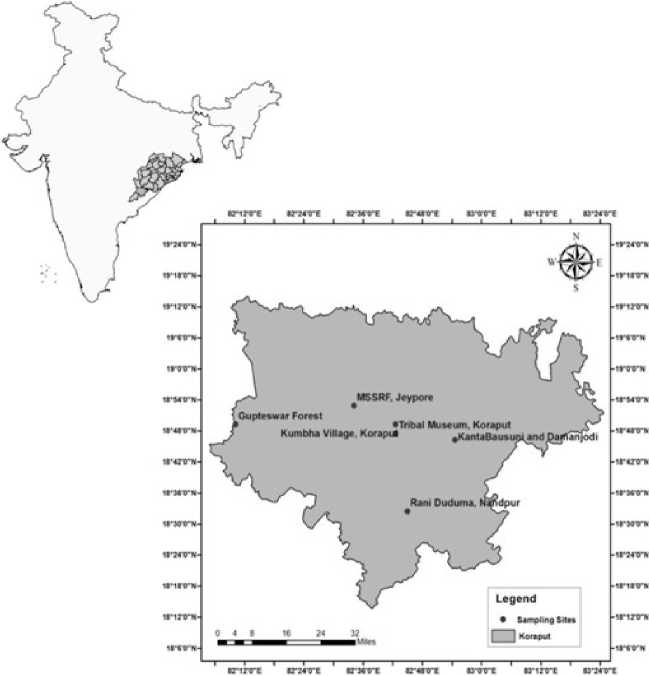
Figure 1 . Map of the study sites in Koraput district of Odisha, India.
Table 1 List of selected plants of Zingiberaceae family used by the tribal people of Koraput.
|
Sl No |
Species Name |
Local Name |
Habitat |
Plant part used |
Medicinal uses |
References |
|
01 |
Zingiber roseum (Roxb.) Roscoe |
Keu Kanda |
Herb |
Rhizome |
Treatment of cancer and inflammation. |
Mittal et al. 2014 |
|
02 |
Curcuma aromatica Salisb. |
Bana Haladi |
Herb |
Rhizome |
Blood purifier, antioxidant, abdominal discomfort and jaundice |
Padhan and Panda, 2016 |
|
03 |
Curcuma amada Roxb. |
Amba Ada |
Herb |
Rhizome |
carminative, cold, stomach ache and sprain |
Padhan and Panda, 2016 |
|
04 |
Zingiber officinale Roscoe |
Ada |
Herb |
Rhizome |
Nausea or arthritis pain. |
Raut et al. 2013 |
|
05 |
Curcuma angustifolia Roxb. |
Palua |
Herb |
Rhizome |
Bronchitis, asthma, cardio tonic, diuretic, indigestion and diarrhoea, |
Padhan and Panda, 2016 |
|
06 |
Alpinia calcarata (Haw.) Roscoe |
Torani |
Herb |
Rhizome |
Rheumatism, weakness, carminative and appetizer. |
Padhan and Panda, 2016 |
|
07 |
Hedychium coronarium J.Koenig |
Phulaka nda |
Herb |
Rhizome |
antihelmintic indications, antiinflammatory and analgesic effects. |
Padhan and Panda, 2016 |
|
08 |
Kaempferia galanga L. |
Bachha |
Herb |
Rhizome |
Indigestion, heart diseases, sore throat, rheumatism, antibacterial and leprosy. |
Padhan and Panda, 2016 |
|
09 |
Curcuma longa L. |
Haladi |
Herb |
Rhizome |
Jaundice, blood purifier, antioxidant, cough, worm infection, skin diseases and stomach disorder. |
Padhan and Panda, 2016 |
|
10 |
Curcuma caesia Roxb. |
Kala Haladi |
Herb |
Rhizome |
For the treatment of leucoderma, asthma, tumor and piles |
Dhal et al. 2012 |
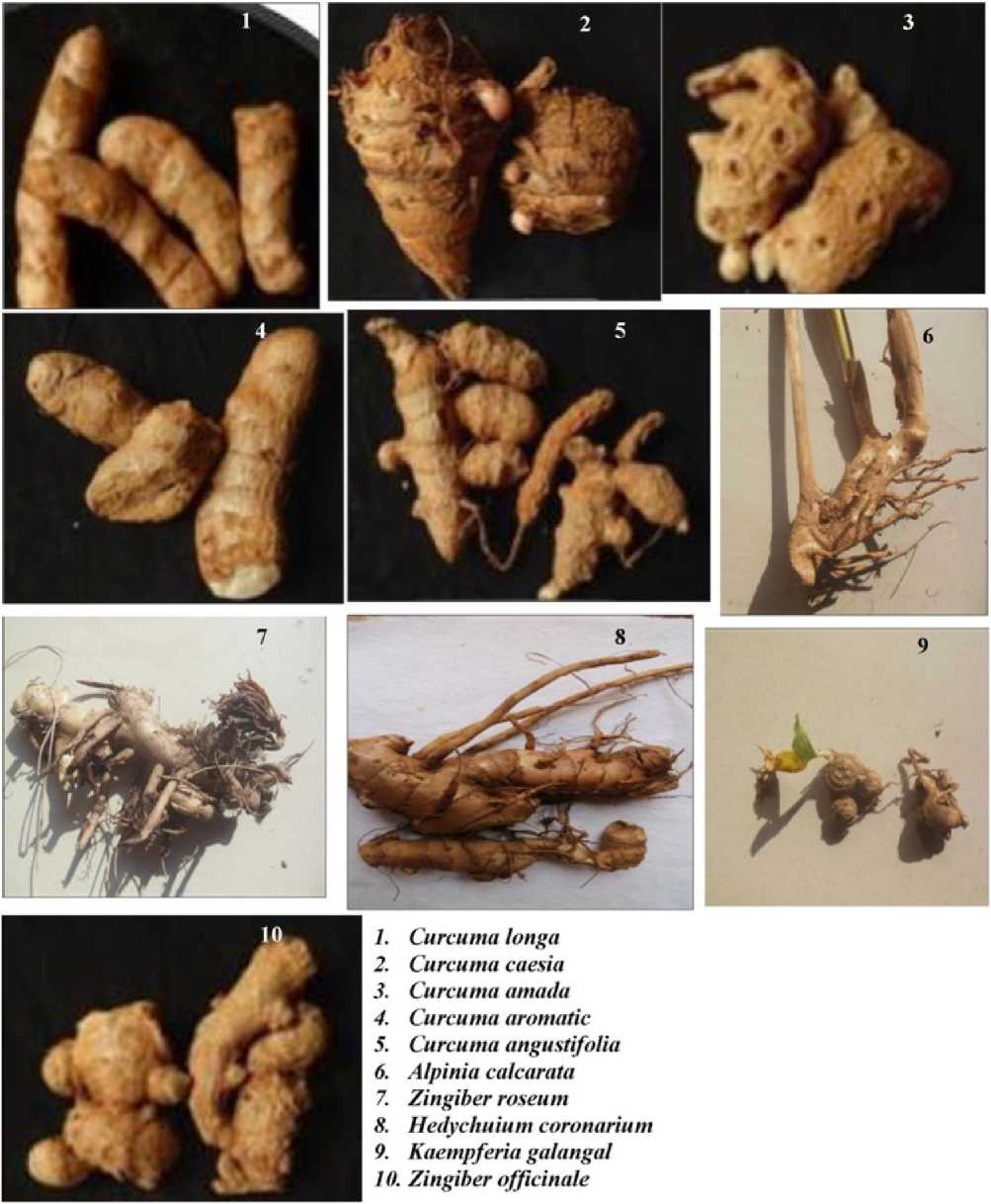
10. Zingiber officinale
Curcuma longa Curcuma caesia Curcuma amada Curcuma aromatic Curcuma angustifolia Alpinia calcarata Zingiber roseum Hedychuium coronarium Kaempferia galangal
x
Figure 2. Rhizomes of different genus of Zingiberaceae family used by the tribal people of Koraput, India
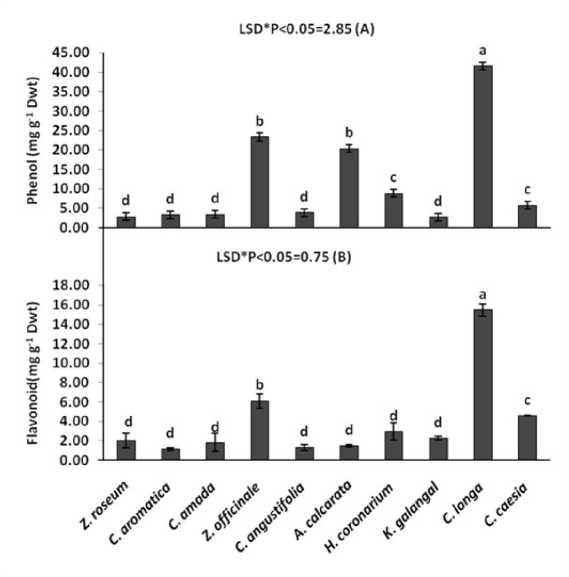
Figure 3. Phenol (A) and Flavonoid (B) (mg g-1 Dwt.) content of different genus of Zingiberaceae family
ISD'PO.05=0.83 {A)
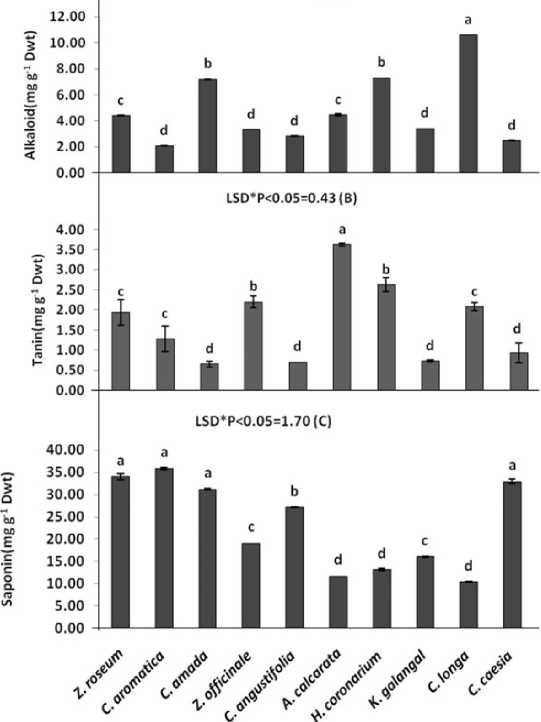
Figure 4. Alkaloid (A), Tannin (B) and Saponin (C) (mg g-1 Dwt.) content of different genus of Zingiberaceae family
LSD*P<0.05=0.02 (A)
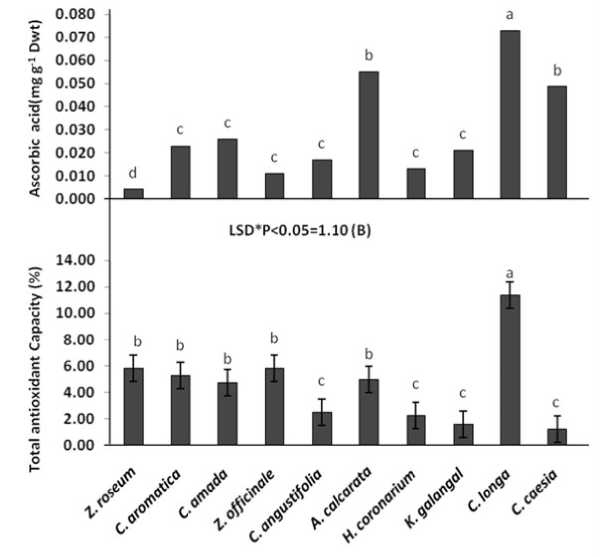
Figure 5. Ascorbic acid (A) and Total antioxidant capacity (B) content of different genus of Zingiberaceae family
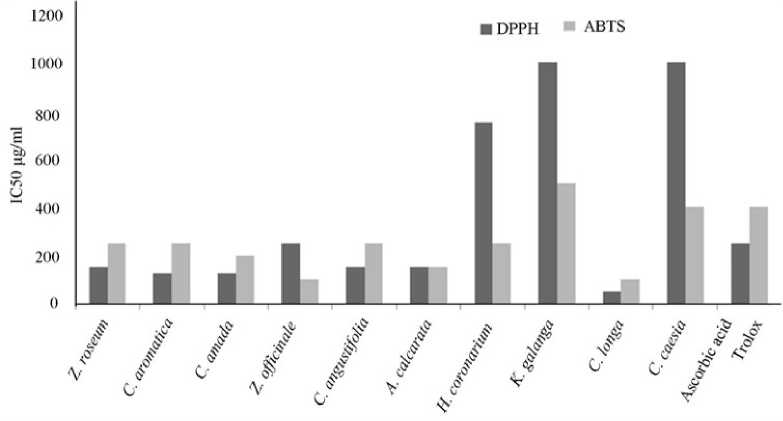
Figure 6. IC 50 values of the rhizome extract of different genus of Zingiberaceae family
In vitro antioxidant activity
The radical scavenging activity of the selected species of Zingiberaceae extract was measured by determining the ability to scavenge different free radicals such as DPPH and ABTS. The capacity to scavenge these free radicals was compared with the activity of standards such as ascorbic acid and trolox (Fig. 6). The total antioxidant activity was assessed by IC50 value on using DPPH and ABTS radical scavenging assay. The results of DPPH radical scavenging activities revealed that, six species had higher scavenging activity than the standard ascorbic acid. Most of the sample extracts showed higher scavenging activity at the concentration between 50 to 250 µg ml-1 except H. coronarium, K. galanga and C.caesia (Fig. 6). The scavenging effects of the yam species on the basis of IC50 value were in the following order: C. longa > C. aromatic and C. amada > C. angustifolia, A. Calcarata and Z. roseum > Z. officinale and Ascorbic acid > H. coronarium > K. galanga and C.caesia. The C. longa showed highest scavenging activity against DPPH radicals with IC50 value of 50.23 µg ml-1 whereas, lowest scavenging activity was observed in K. galanga and C. caesia with the IC50 of 1000.45 and 1000.87 µg ml-1respectively (Fig. 5). Similarly, the ABTS radical scavenging activity was higher in Z. officinale and C. longa followed by > A. calcarata > C. amada > Z. roseum, C. aromatica, C. angustifolia and H. coronarium > C.caesia and trolox > K. galanga (Fig. 5). The IC50 values for Z. officinale and C. longa was 100.57 µg ml-1 respectively with higher scavenging activity than the standard (Fig. 6). Taken together, phytochemical analysis of these plants revealed that some plants are promising sources of several chemical constituents like alkaloids, flavonoids, phenols and antioxidants with free radical scavenging activity in varying proportions and possess therapeutic substances.
CONCLUSION
The present study gives the baseline information on phytochemicals present in selected plants of Zingiberaceae used by tribal people of Koraput. Phytochemical compositions of these plants indicates that the phenol, flavonoid, alkaloid, saponin, tannin, ascorbic acid, total antioxidant content and antioxidant activity are major pharmaceutical parameters that are responsible for ethnomedicinal value are present in varying proportions.The plants are also contain significant amounts of antioxidants that can be exploited as a potential source for herbal remedy for various diseases. Thus, public awareness and communitybased programmes need to be encouraged at all levels for ex situ and in situ conservation of such species and will further use in exploration of new drugs for pharmaceutical industries.
ACKNOWLEDGEMENTS
Список литературы Chemical profiling of selected plants of Zingiberaceae used in Ethnomedicine of Koraput, India
- Atmani, D., Chaher, N., Berboucha, M., Ayouni, K., Lounis, H., Boudaoud, H., Debbache, N. and Atmani, D. (2009). Antioxidant capacity and phenol content of selected Algerian medicinal plants. Food Chemistry, 112 (2), 303-309
- Blois, M. S. (1958). Antioxidant determination by the use of a stable free radical. Nature, 181, 1199-1200
- Burkill, I. H. (1996). The useful plants of West tropical Africa. Royal Botanic. Garden, 2, 29-30
- Chan, E.W.C., Lim, Y.Y., Wong, L. F., Lianto, F.S., Wong, S.K. and Lim, K.K. (2008). Antioxidant and tyrosinase inhibition properties of leaves and rhizomes of ginger species. Food Chemistry, 109, 477-483
- Chang, C.C., Yang, M.Y. and Wen, H. M. (2002). Estimation of Total Flavonoid Content in Propolis by Two Complementary Colorimetric Methods. Journal of Food Drug Anaysis, 10, 178-182
- Eleazu, C.O., Kolawole, S. and Awa, E. (2013). Phytochemical composition and antifungal actions of aqueous and ethanolic extracts of the peels of two yam varieties. Medicinal and aromatic Plants, 2 (4), 128
- Gislene, G.F, Locatelli, N.J., Paulo, C.F. and Giuliana, L.S. (2000). Antibacterial activity of plant extracts and phytochemicals on antibiotic resistant bacteria. Brazilian Journal of Microbiology, 31, 247-256
- Halliwell, B. (2008). Are polyphenols antioxidants or pro-oxidants? What do we learn from cell culture and in vivo studies? Archives of Biochemistry and Biophysics, 476, 107-112
- Han, X., Shen, T. and Lou, H. (2007). Dietary polyphenols and their biological significance. International Journal Molecular Science, 8, 950-988
- Harborne, J.B. (1973). Phytochemical methods, London. Chapman and Hall, Ltd. London, UK, Pp: 49- 188
- Huang, W., Xue, A., Niu, H., Jia, Z. and Wang, J.W. (2009). Optimised ultrasonic-assisted extraction of flavonoids from Folium eucommiae and evaluation of antioxidant activity in multi-test systems in vitro. Food Chemistry, 114 (3), 1147-1154
- Hussain, A., Virmani, O.P., Popli, S.P., Misra, L.N., Gupta, M.M., Srivastava, G.N., Abraham, Z. and Singh, A.K. (1992). Dictionary of Indian Medicinal Plants. CIMAP, Lucknow, India, pp: 546
- Jain, S. K. and Ved, Prakash. (1995). Zingiberaceae In india: Phytogeography and endemism. Reedea, 5 (2), 154-169
- Larsen, K., Ibrahim, H., Khaw, S. H. and Saw, L. G. (1999). Ln: Wong KM(Ed) Gingers of peninsular Malayasia and Singapore, Natural History publications, Borneo, pp: 1-92
- Mahapatra, A.K. and Panda, P.C. (2012). Wild edible fruit diversity and its significance in the livelihood of indigenous tribals: Evidence from eastern India. Food Security, 4, 219-234
- Mishra, M.K., Panda A. and Sahu D. (2012). Survey of useful wetland plants of south Odisha, India. Indian Journal of traditional knowledge, 11 (4), 658-666
- Mishra, S. and Chaudhury, S.S. (2012). Ethnobotanical flora used by four major tribes of Koraput, Odisha, India. Genetic Resource and Crop Evolution, 59, 793-804
- Mishra, S., Swain, S., Chaudhary, S.S. and Ray, T. (2008). Wild edible tubers (Dioscorea spp.) and their contribution to the food security of tribes of Jaypore tract, Orissa, India. Plant Genetic Resource Newsletters, 156, 63-67
- Mishra, S. and Mishra, M.K. (2013). Leafy Vegetable Plants of South Odisha, India. International Journal of Agricultural and Food Science, 3 (4), 131- 137
- Misra, S. and Misra, M.K. (2014). Nutritional Evaluation of some edible underground plant parts used by tribal people of South Odisha, india. Nelumbo, 56, 225-233
- Nahapetian, A. and Bassiri, A. (1975). Changes in concentration and interrelationship of phytate, P, Mg, Cu, Zn, in wheat during maturation. Journal of Agricultural Food Chemistry, 32, 1179-1182
- Okwu, D.E. and Okwu, M.E. (2004). Chemical composition of Spondias mombin Linn. plant parts. Journal of Sustainable Agriculture and Environment, 6 (2), 140-147
- Omaye, K.A., Reddy. and Cross, C.E. (1962). Enhanced lung dystrophy in vitamin-E deficient rabbits. Journal of Bioogical Chemistry, 237, 916-921
- Padhan, B. and Panda, D. (2016) Wild tuber species Diversity and its ethnomedicinal use by tribal people of Koraput district of Odisha, India. Journal of natural products and Reseources, 2 (1), 33-36
- Padhan, B. and Panda, D. (2015). Wild edible plant Diversity and its ethnomedicinal use by indigenous tribes of Koraput, Odisha, India. Research Journal of Agriculture and Forestry Sciences, 3 (9), 1-10
- Pakrashi, S.C. and Pakrashi, A. (1995). A versatile healing herb-Ginger
- Paramapojn, S., Tip-pyang, S., Gritsanapan, W. (2009). High-performance liquid hromatographic analysis of selected bioactive components in Zingiber cassumunar Roxb. International Journal Biomedical and Pharmaceutical Science, 3, 34-38
- Peter, K.V. (2007). Underutilized and under exploited horticultural crops. Vol-1. -
- ISBN: 978-8189422608
- Peter, K.V. (2004). Handbook of Herbs and Spices. Cambridge, GBR. Wood head Publishing, Limited,
- ISBN: 9781855738355
- Prieto, P., Pineda, M. and Anguilar, M. (1999). Spectrophotometric Quantitation of Antioxidant Capacity through the formation of a Phosphomolybdenum Complex: Specific Application to the Determination of Vitamin E. Analytical Biochemistry, 269, 337- 341
- Raut, S., Sen, S.K., Satpathy, S. and Pattnaik, D. (2013). An Ethnobotanical survery of medicinal plants in Semiliguda of Koraput district, Odisha, India, Research Journal of Recent Science, 2(8), 20-30
- Re, R., Pellegrini, N., Proteggente, A., Pannala, A., Yang, M. and Rice-Evans, E. (1999). Antioxidant activity applying an improved ABTS radical cation decolonization assay of free radical. Bio medical, 26, 1231-1237
- Sadasivam, S. and Manickam, A. (2007). Biochemical Methods. New Age International (P) Limited, Biochemistry, pp. 284
- Saxena, H.O. and Brahmam, M. (1994-1996). The Flora of Orissa. Orissa Forest Development Corporation Ltd., Bhubaneswar
- Singh, A.K., Singh, S. and Singh, D.K. (2003). Pharmacological effect of species. In, Recent progress in medicinal plants phytochemistry and pharmacology, J, N.Govil, V.K Singh (Eds). Houston texa USA stadium press LLC. 2, 321-53
- Sivarajan, V.V. and Balachandran, I. (1994). Ayurvedic drugs and their Plant Sources. Oxford and IBH Publishing Co. Pvt. Ltd., New Delhi, pp. 570
- Soepadmo, E. (1976). Ginger plants. Nature Malayasia, 1, 32-39
- Sreevidya, N. and Mehrotra, S. (2003). Spectophotometric method for estimation of alkaloids with precipitable with dragendroff's reagent in plant material. Journal of AOAC International, 86 (6)

